- Bernard Preston homepage
- Solar geek
- 12 24 Or 48V Solar Generator
12, 24 or 48V solar generator?
12, 24 or 48V solar generator is an important question to answer before setting out.
There are few things more important to face squarely before starting out on this little venture of building a solar farm.
Firstly the setup costs are substantial and trying to do it on the cheap is the direct route to heartache. Doing it right the first time means it hurts only once.
Mistake number one, for me, was a 24V MPPT and 2kW inverter. You will want to grow your generating plant so make provision for that from the very start.
Muddying the water is that technology is advancing very quickly; keep that in the back of your mind.
But do not let it hold you back from getting your big-toe into the solar ocean.
This page was last updated by Bernard Preston on 9th March, 2023.
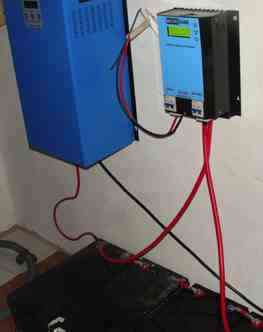
Secondly forget the ego and glamour of being off the grid and making a contribution to the environment; and all that stuff. You really need to be hard-nosed about it; otherwise you are going to be ranting.
Perhaps lower your expectation to begin with, keeping in mind that technology is expanding at a rate of knots; what is impossible today may well be plausible tomorrow.
I know because I have the T-shirt. Do it right the first time.
The folk I come into contact with who are fed up with their solar farms are those who build a Mickey-Mouse 12V system with less than one kW of panels. A low voltage means high current, and with it significant heat losses in the cabling. You will also be overly stressing your inverter and batteries continuously and like the proverbial candle they will not last the night.
The other disadvantage is that you cannot easily expand the system. You will be astonished how quickly the greed-factor kicks in; once you discover that sunshine is free, you will start wanting your solar generator to do a lot more than run the computer and supply a few LED lights.
I started with a small system, just for lights and computers. Then South African started experiencing almost daily load-shedding, often with no warning and we started to think about running the fridge. So we upgraded at considerable unnecessary expense to 24V and an extra battery, as in the graphic above.
Then the good wife wanted to cook in the electric-oven, and I needed power to run my carpentry tools; another expensive upgrade to 48V.
Do it right the first time. A Mickey Mouse 12V solar generator will not do much for the environment; and it will frustrate you. Bite the bullet and go straight to a forty-eight volt setup. In fact today they have gone up to into the hundreds but that's not for the amateur to mess around with; direct current is even more dangerous than AC.
12, 24 or 48V solar generator
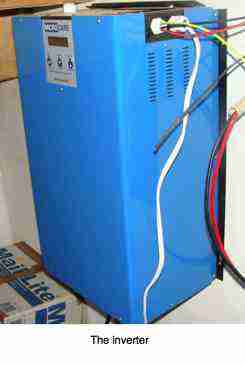
12, 24 or 48V solar generator will determine whether you end up being a happy greenie, or not.
This is a 24V inverter; it is a move in the right direction but not far enough.
Let me explain.
There are two important formulae to grasp.
- V = IR
Increasing the voltage V by a factor of 4 from 12 to 48 means dropping the current I by a quarter, where R is the resistance.
- Heat losses = current squared x resistance.
If you drop the current by a factor of 4, then the heat losses decrease by a fourth squared; in other words sixteen.
Trust me I am a doctor. I am also a physics major. Do not put in a 12 or 24V solar generator; go straight to 48.
If you cannot grasp the basic math and physics here, then it is best you do not build your own solar generator.
Building a 12V Mickey-Mouse solar generator will not do much for the environment, nor will it satisfy your aspirations.
You'll be told that it is a lot more expensive and, yes, it is because you need more or better batteries; but your cabling could be one sixteenth as thick compared to 12V, and you will not need to go through the pain of upgrades like I have.
There is a downside; well, really it is not a disadvantage in the long run. You must have at least four 12V batteries to make up 48 instead of only one; a significantly greater initial outlay.
These days go straight to a lithium battery. Doesn't a 10-year guarantee sound attractive?
But that means four times the storage capacity, and you won't drain your battery on the first night, ruining it, like a friend did.
In short if you only have a thousand dollars, forget the environment, ignore your supplier and go out and buy a petrol generator. It's not really satisfactory, but you will be a lot less unhappy than with a 12V solar system.
You see your regulator, called a MPPT, and your inverter are dependent on the voltage. To change from 12 to 24V and then maddeningly to 48 is an expensive and frustrating business. Do it right the first time, even if you think you will never expand your system. It's guaranteed you will want to; and will not be able to, except at great cost.
It really is frustrating having to return your components and plead with the supplier to trade them in and ask for a good price on an upgrade. Plus they are heavy, and the courier charges are exorbitant.
Am I making myself clear? You see, I have the T-shirt. Do it right the first time, and go straight to 48V.
Newsletter
Our newsletter is entitled "create a cyan zone" at your home, preserving both yourself and Mother Earth for future generations; and the family too, of course. We promise not to spam you with daily emails promoting various products. You may get an occasional nudge to buy one of my books.
Here are the back issues.
- Lifestyle and ideal body weight
- What are ultra-processed foods?
- Investing in long-term health
- Diseases from plastic exposure
- Intensive lifestyle management for obesity has limited value
- A world largely devoid of Parkinson's Disease
- The impact of friendly bacteria in the tum on the prevention of cancer
- There's a hole in the bucket
- Everyone is talking about weight loss drugs
- Pull the sweet tooth
- If you suffer from heartburn plant a susu
- Refined maize meal and stunting
- Should agriculture and industry get priority for water and electricity?
- Nature is calling
- Mill your own flour
- Bake your own sourdough bread
- Microplastics from our water
- Alternative types of water storage
- Wear your clothes out
- Comfort foods
- Create a bee-friendly environment
- Go to bed slightly hungry
- Keep bees
- Blue zone folk are religious
- Reduce plastic waste
- Family is important
- What can go in compost?
- Grow broad beans for longevity
- Harvest and store sunshine
- Blue zone exercise
- Harvest and store your rainwater
- Create a cyan zone at your home
Incidentally be careful because the direct current produced by your solar panels bites; even worse than AC. Never open the circuit on a summer's day when your PVs are pumping. I cover them with blankets when I am connecting wires, and drop the breaker at the MPPT if worried about electrocuting myself.
You may be dealing with up to 150V and that gives a very significant jolt with direct current; it does not let go like AC does. The burns I'm told are bad.
More about volts
Recently when servicing one of the panels in a string of three, I temporarily connected only two; late in the afternoon they read 62V and were supplying 220W.
When again connecting the third PV panel in series, the voltage rose to 94V, but here's the interesting part, the wattage shot up to 520, more than double.
The higher the voltage, the more efficient the whole system becomes, with fewer losses in the cabling and probably elsewhere too.
Solar charge controller
The solar charge controller, or MPPT as it's known, enables your batteries to draw a lot more energy from the panels; it keeps the voltage in the wiring near to 150V instead of around the 10V of a flat battery; that improves the efficiency enormously. You simply can't do without the maximum power point tracker.
Read more about this subject at solar charge controller MPPT.
Inverter for home
The inverter for your home that you choose is an ultra important choice. If you can possibly afford it, go for the biggest that is in your price range, because you'll be otherwise upgrading shortly at unnecessary extra cost; I have already made it clear whether I would choose a 12, 24 or 48V solar generator.
How I wish that I had gone straight to this 10kW beauty; it's been a difficult learning curve and you can learn from my mistakes. Go big as you can afford from the beginning; "Big Boy" only comes in the 48V system.
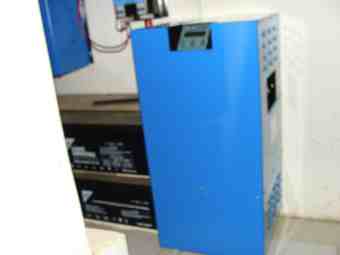
Finally I made the right decision; a 48V system with a lovely powerful inverter. I just wish somebody had advised me to go straight here from the beginning; I would have saved myself a bundle and a lot of frustration.
Now we can use the electric oven, during the day when the sun is shining. The hob is still propane gas but we barely use it because of that induction cooktop stove that you can see below on the left; it uses half the electricity and heats at twice the speed.
A solar electric oven is a treat; it draws 2.0kW which the inverter handles with ease, but only when the sun is shining brightly. In fact, I put up an extra 900 watts of PV's facing west just so Helen could bake and roast in the late afternoon.
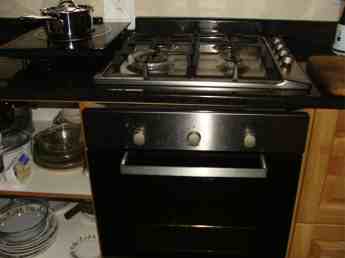
Most of the the excess power during the day is mopped up by the solar swimming pool motor and chlorinator; and now the E-car has landed.
A pool is a luxury in these days of high electricity prices, using about 8 units per day but your solar generator will handle it with ease.
It looks a bit like the Martians landed on the roof in the night!
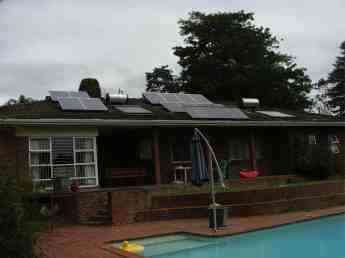
And I can mow the grass, use my carpentry tools and bake bread; and do anything and everything, but only on a sunny day. To do that in inclement weather you would need a huge bank of batteries. I am not in favour of going off the grid; it is a lovely romantic notion, but not cost effective.
But we have chose to change over to prepaid electricity for special needs like a hot bath during extended inclement weather. The mains breaker stays firmly in the off-position for most of the time to prevent any grid surges getting into our home.
Since writing this some five years ago, the price of lithium batteries has come down dramatically and we are in the happy position of being able to go off the grid, though we have not yet done so; and probably will not. For a time we flirted with the idea of a gas geyser backup for the five-day mists that sometimes cover our village; that we luckily eventually spurned.
“Expectations make people miserable, so whatever yours are, lower them. You will definitely be happier.”
Simone Elkeles
Yes and no, is my response. Having high expectations has enabled us to reduce our utility consumption to 5kWh in the last year. Despite what I wrote above, we will consider going off the grid if Eskom introduces line charges.
- Return from 12, 24 or 48V generator to solar power energy homepage.
- For another slant on the subject read 12V or 24V.
When browsing use right click and "Open Link in New Tab" or you may get a bad gateway signal.
Bernard Preston
Bernard Preston is a physics-major who, after seven years of teaching science turned to something quite different; well-being with spinal adjustments.
Yet his love for the physical sciences has never left him and retirement has provided the time and space to return to his roots.
Nurture something that you are passionate about, even in your dotage, or fall off the planet from boredom long before your time. Mine is caring for both our human frames and the planet; the philosophy can be summarised in what is a cyan zone?
Did you find this page interesting? How about forwarding it to a friendly book or food junkie? Better still, a social media tick would help.
- Bernard Preston homepage
- Solar geek
- 12 24 Or 48V Solar Generator
Address:
56 Groenekloof Rd,
Hilton, KZN
South Africa
Website:
https://www.bernard-preston.com